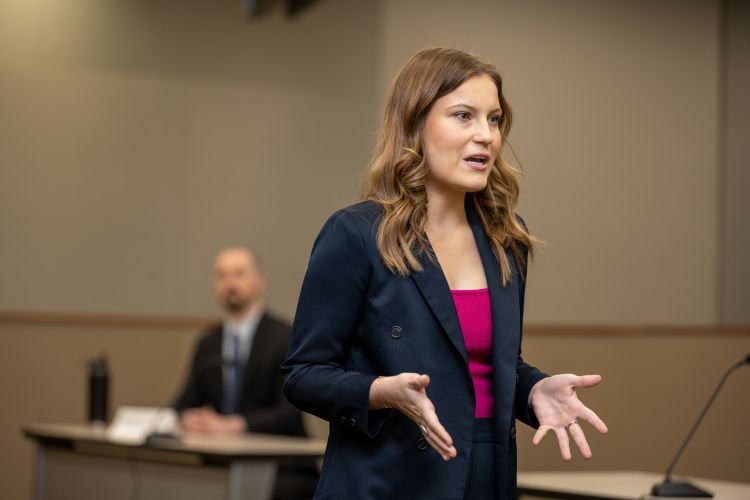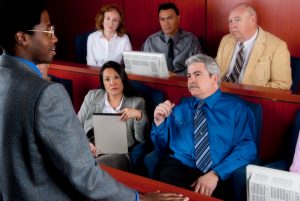Understanding the Art of Trial Presentations: Secret Approaches for Effective Legal Arguments
Understanding the Art of Trial Presentations: Secret Approaches for Effective Legal Arguments
Blog Article
Navigating the Complexities of Test Presentations: Tips for Seamless Distribution and Engaging Arguments
In the realm of legal procedures, the art of test presentation stands as an essential factor of success. The complexities integral in test presentations call for a delicate balance of skill, approach, and ability.

Understanding Trial Objectives
To successfully browse a trial, it is important to have a clear understanding of the purposes that need to be accomplished. Prior to tipping right into the court, lawful groups have to define their goals and desired results. These goals act as assisting concepts throughout the test, forming strategies and influencing decision-making processes.
Understanding trial goals includes a detailed evaluation of the situation, legal precedents, and the client's finest rate of interests. Trial Presentations. It requires a careful assessment of the truths, determining crucial problems, and expecting prospective challenges. By setting quantifiable and details goals, attorneys can tailor their discussions and debates to line up with the preferred results
Moreover, a clear grip of test goals enables lawful groups to prioritize evidence, witnesses, and lawful disagreements efficiently. It allows for the development of a systematic narrative that resonates with the court and court, strengthening the total instance presentation.

Organizing Evidence Effectively
Having a clear understanding of test goals lays the foundation for organizing proof properly in legal proceedings - Trial Presentations. By aligning the discussion of evidence with the desired end results of the trial, lawful groups can reinforce their disagreements and enhance their persuasiveness. One crucial facet of arranging evidence is classification. Grouping evidence based upon themes or relevance to certain legal components can help simplify the discussion and make complex details a lot more digestible for the court or jury.
Another crucial element in arranging evidence properly is establishing a sensible flow. Providing proof in a sequential and meaningful fashion can assist construct an engaging narrative that sustains the lawful disagreements being made. In addition, using visual help such as timelines, charts, or charts can even more improve the company of evidence and help in making clear complex connections or series of occasions.
Furthermore, making sure that all evidence presented is acceptable and pertinent to the situation is crucial. Irrelevant or inadmissible proof can take away from the toughness of the debate and possibly damage the reliability of today event. Consequently, a meticulous review and selection process ought to be embarked on to consist of just one of the most legitimately audio and impactful evidence in the test presentation.
Crafting Influential Narratives
Crafting compelling narratives plays an essential function in offering influential debates during legal proceedings. A well-crafted narrative has the power to captivate the audience, evoke emotions, and inevitably sway the decision for the here and now party. When constructing a narrative for a trial presentation, it is vital to establish a clear storyline that highlights bottom lines and attaches them in a systematic way. Begin by detailing the truths of the situation in a compelling manner, ensuring that the series of occasions is very easy to comply with. Introduce characters effectively, providing history details that helps the target market comprehend their activities and inspirations. Furthermore, incorporating vivid summaries and appealing language can bring the narrative to life, making it more remarkable for the discretionary. By weaving together evidence, testimony, Check This Out and lawful debates into a cohesive and influential narrative, attorneys can successfully advocate for their customers and boost the possibility of a beneficial outcome in the court room.
Grasping Aesthetic Aids
Efficient use aesthetic help is vital to enhancing the effect and quality of trial presentations. Aesthetic help, when utilized tactically, have the power to streamline intricate information, strengthen vital points, and leave an enduring impact on the court and jury. To master visual help in test discussions, it is essential to make sure that they are clear, succinct, and pertinent to the arguments being made.
When incorporating visual help, such as charts, timelines, charts, or pictures, into a trial presentation, it is vital to maintain them aesthetically appealing yet professional. The visuals ought to match the verbal disagreements, offering a graph of the info being talked about without overwhelming the audience with unnecessary details.
Moreover, experimenting the aesthetic help ahead of time is imperative to ensure a smooth distribution throughout the test. Familiarizing oneself with the content, transitions, and timings of each aesthetic help can aid preserve the flow of the presentation and prevent technical problems that may emerge.
Supplying Impactful Closing Arguments
An engaging closing debate works as the conclusion of a trial discussion, enveloping the core narrative and persuading the blog court and court towards a beneficial choice. To supply an impactful closing disagreement, it is important to succinctly wrap up bottom lines, highlight the toughness of your situation, and deal with any weak points in a tactical manner. Begin by laying out the primary arguments that sustain your client's placement, highlighting why the evidence offered throughout the trial supports your story. It is necessary to create a feeling of cohesion and quality, directing the discretionary in the direction of the preferred verdict.
In addition, incorporating sob story can even more reinforce your closing argument. By humanizing the situation and attaching on an individual level with the decision-makers, you can evoke compassion and understanding, affecting their perception of the truths offered. Additionally, repeating the lawful standards that should be satisfied for a desirable ruling can reinforce the credibility of your placement. Inevitably, a well-crafted closing argument ought to leave an enduring impact, engaging the discretionary to regulation in your client's favor.
Final Thought
In final thought, grasping test presentations includes comprehending goals, organizing evidence, crafting narratives, utilizing visual aids, and delivering impactful closing debates. By implementing these methods properly, legal representatives can provide their situation perfectly and make compelling arguments in the courtroom. It is crucial to browse the intricacies of test presentations with precision and ability to attain success in lawful procedures.
By lining up the presentation of evidence with the wanted end results of the trial, legal groups can reinforce their disagreements and enhance their persuasiveness (Trial Presentations). To understand aesthetic aids in trial discussions, it is important to guarantee that they are clear, concise, and pertinent to the debates being made
An engaging closing argument offers as the conclusion of a trial discussion, encapsulating the core narrative and encouraging the judge and court in the direction of a beneficial choice. Begin by detailing the main debates that support your customer's placement, try here highlighting why the proof provided throughout the trial sustains your narrative.In final thought, mastering test presentations entails understanding purposes, organizing proof, crafting narratives, making use of visual help, and supplying impactful closing disagreements.
Report this page